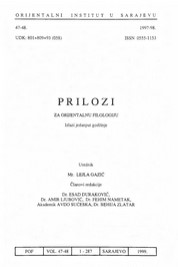ADVERBIJALIZACIJA U TURSKOME JEZIKU
ADVERBIALISATION IN THE TURKISH LANGUAGE
Author(s): Ekrem ČauševićSubject(s): Theoretical Linguistics, Syntax, Semantics, Comparative Linguistics, South Slavic Languages, Philology, Turkic languages
Published by: Orijentalni Institut u Sarajevu
Keywords: Adverbialization; Turkish language; Transformations of the finite object into infinite; Sentence analysis; Semantic analysis;
Summary/Abstract: In the Turkish language we differentiate between two basic transformations of the finite object (VF) into infinite: 1) VF -> verbal noun [-mak, -ma, -(y)ış, -dik, -(y)acakj; 2) VF —» participle; 3) VF —» gerund. If a result clause (e.g. Ayşe kapıyı açtı.) is incorporated into a matrix sentence (e. g. Hırsız pencereden atladı.) so that its finite object transforms into a gerund (e. g. Ayşe kapıyı açtı —> Ayşe kapıyı açınca), such a transformation is called adverbialization. In the structure of a simple clause (1) Ayşe kapıyı açınca // (2) hırsız pencereden atladı we can differentiate between two segments: (a) basic segment (numbered as 2) or matrix sentence into which incorporated is the transformed result clause; b) gerund segment (numbered as 1) whose infinite object (= gerund) is a contact line between the incorporated clause and matrix sentence. The gerund segment as the sentence constituent part is analyzed according to three criteria: a) structure, b) function and c) semantics (determining semantic equivalents in the language Turkish is being compared to). Semantic analysis of the Turkish gerund through contrasting it with adequate adverbial clauses in the Bosnian language is the Central point of this paper.
Journal: Prilozi za orijentalnu filologiju
- Issue Year: 1997
- Issue No: 46
- Page Range: 13-37
- Page Count: 25
- Language: Bosnian

